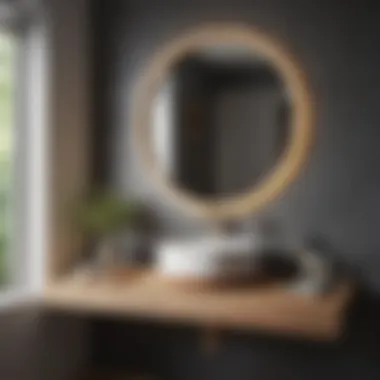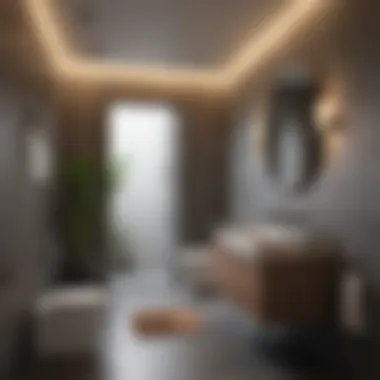Cost Analysis of Remodeling a Tiny Bathroom


Intro
Remodeling a tiny bathroom can feel overwhelming. The limited space constricts choices and often elevates costs. Homeowners and renters must balance aesthetics with practical functionality. As you embark on this project, understanding the financial implications is crucial.
This article will explore various cost factors associated with tiny bathroom renovations. From material selection to labor, each aspect carries potential influence over your total expenditure. Armed with this understanding, intelligent budgeting becomes possible, allowing for both style and utility in your bathroom space.
With so many styles and color palettes available, choices may vary greatly. Budget considerations must align carefully with personal preferences, making it essential to analyze options thoroughly. Whether you aim for modern minimalism or a cozy rustic feel, the right plan can lead to an alluring yet practical bathroom.
Understanding Tiny Bathroom Remodeling
Remodeling a tiny bathroom involves a unique set of challenges and opportunities. These compact spaces often require thoughtful planning and precise execution to make the most of limited square footage. Understanding the specific requirements of tiny bathrooms opens a pathway for homeowners to enhance both functionality and aesthetics. In this section, we will explore the key characteristics of these small spaces and the reasons why remodeling them can yield significant benefits.
Defining Tiny Bathrooms
A tiny bathroom is typically classified as a space measuring less than 50 square feet. However, the exact definition can vary depending on regional norms and personal perception. Common features of tiny bathrooms include:
- Limited floor space making movement and storage more challenging.
- Essential fixtures like toilets, sinks, and showers often coexist in a confined area.
- Necessity of utilizing vertical space for storage and organizational purposes.
By understanding what constitutes a tiny bathroom, homeowners can set realistic goals for their remodeling projects. These goals may include optimizing storage options, improving overall layout, and selecting materials that not only look appealing but also save space.
Importance of Remodeling
Remodeling a small bathroom can significantly impact both daily living and property value. Here are some important reasons to consider:
- Increases Functionality: An updated design can improve the workflow within the bathroom. Introducing elements like wall-mounted sinks or compact vanities can assist in maximizing usability in a smaller area.
- Enhances Aesthetic Appeal: A fresh look can drastically change the atmosphere of the bathroom. Consider using light colors and modern fixtures to create a more inviting space.
- Improves Property Value: Well-executed remodeling can enhance the overall value of a home. Potential buyers often pay close attention to bathroom conditions, making this type of renovation an asset when selling a property.
- Adapts to Current Needs: Changes in lifestyle may demand an updated bathroom. Whether it is adding accessibility features for aging-in-place or creating a more functional space for daily routines, remodeling allows for these adaptations.
"Every small change can lead to substantial improvements in how a bathroom functions and feels."
In summary, knowing the specifics of tiny bathrooms and understanding the value of remodeling helps homeowners prepare for successful renovations. This groundwork will assist us as we move forward to analyze further costs and factors influencing remodeling decisions.
Factors Influencing Remodel Cost
Remodeling a tiny bathroom is a task that involves numerous considerations, particularly regarding costs. Understanding the factors influencing remodel costs is essential for anyone looking to undertake this project. By grasping these elements, homeowners can make informed decisions that fit their budgets while achieving the desired aesthetic and functionality.
Size and Layout Constraints
The size and layout of a tiny bathroom are critical aspects when evaluating renovation costs. Smaller spaces can limit options for fixtures and layouts, often pushing homeowners to be innovative in their designs. One must carefully consider how every square inch of space will be utilized. For example, selecting a compact sink or a corner shower can free up valuable room.
Additionally, layout constraints may necessitate plumbing adjustments, which can be significant in terms of expense. Moving plumbing or electrical fixtures often increases labor costs, as special skills are required to ensure code compliance.
Quality of Materials
The quality of materials chosen for the remodel plays a significant role in overall costs. High-end materials may improve durability and visual appeal but can also inflate budgets rapidly. Conversely, opting for budget-friendly alternatives may cut immediate costs but could lead to higher maintenance and replacement expenses in the long term.
Examples of material categories to consider include:
- Tiles: Porcelain and ceramic tiles can vary significantly in price. While ceramic is usually more affordable, porcelain is denser and more durable.
- Fixtures: Investing in quality fixtures, like faucets and showerheads, can improve functionality and longevity.
- Countertops: Solid surface countertops provide durability but at a higher cost than laminate. Choosing wisely can balance aesthetics and affordability.
Labor Costs


Labor costs are an essential consideration in any remodeling project, including tiny bathrooms. Hiring skilled technicians ensures that work is done safely and to a high standard. However, skilled labor comes at a premium. The complexity of the project can affect pricing; for instance, if extensive plumbing or electrical work is necessary, costs can rise accordingly.
It is also beneficial to gather multiple estimates from contractors before making a decision. This can help in understanding current market rates and enables informed negotiations. Make sure to check the contractor’s credentials and reviews to avoid unexpected costs or poor work quality.
Permits and Regulations
Before undertaking a remodel, it is crucial to consider local regulations and necessary permits. Many municipalities require permits for structural changes, plumbing, or electrical work. Failing to acquire the right permits can lead to fines or complications when selling the property in the future.
The costs associated with permits can vary widely depending on location. Homeowners should check local regulations to ensure compliance, which can prevent unexpected expenses that may arise from doing work without the required permissions.
"Understanding local regulations and obtaining the necessary permits is essential in avoiding fines and ensuring a smooth remodeling process."
In summary, the factors influencing remodel costs are numerous, each intertwined with many considerations. Whether deciding on materials, calculating labor, or navigating regulations, each element contributes to the overall expense of a tiny bathroom remodel. By being diligent and informed, homeowners can manage these factors effectively.
Average Cost Breakdown
Understanding the average costs involved in a tiny bathroom remodel is crucial for any homeowner planning to undertake such a project. This section dissects the various elements of cost that can arise, offering clarity and insight into budgeting effectively. Each component, from demolition to finishing touches, contributes to the overall financial picture, and knowing these can aid in avoiding overwhelming expenses. Awareness of these costs can also influence design choices and material selection that align with one's financial capabilities.
Demolition and Disposal
Demolition and disposal are key first steps in remodeling any space. For tiny bathrooms, these processes are generally less complicated than in larger rooms, but they still require careful planning. The cost for demolition can vary widely based on the extent of the work needed. Removing old fixtures, tiles, and potentially even walls can lead to costs ranging from a few hundred to several thousand dollars.
When considering disposal, it is essential to factor in local regulations regarding waste. Hiring a professional service for disposal might be beneficial, as they can ensure environmentally responsible handling of materials. However, disposing of materials oneself can save money if done correctly. Take note of your local dump fees and recycling options beforehand to make an informed decision regarding this step.
Plumbing and Electrical Work
Tiny bathrooms often have intricate plumbing and electrical systems that need professional expertise to handle modifications, upgrades, or replacements. Plumbing work includes installing new pipes, relocating fixtures, or fixing existing issues, which can cost between $1,000 to $3,000 depending on the complexity and location of your bathroom. This is often vital if you are changing the layout or replacing old systems.
Electrical work is another vital consideration. Adding new lighting, updating outlets, or moving switch placements can range from $500 to $2,000. It is important to hire licensed professionals for this work, as improper installation can lead to safety hazards.
Fixtures and Fittings
Selecting the right fixtures and fittings can significantly influence the budget of a tiny bathroom remodel. These elements include sinks, toilets, faucets, and showers, each available in a wide range of prices. On average, homeowners may spend between $1,000 and $4,000 on fixtures alone. Choices can range from economical options at home improvement stores to high-end designer pieces.
Investing in quality fixtures can lead to long-term benefits, such as durability and aesthetic appeal. Ensure to balance price with function, and don’t hesitate to ask for recommendations for reliable fixtures that fit within your budget.
Flooring and Tiling
Flooring and tiling are critical aspects of bathroom remodels. Options range from vinyl and laminate to ceramic or porcelain tiles. Each has its own costs associated with materials and installation. Generally, expect to spend between $1,500 and $3,500 for flooring, which includes both the material price and labor costs.
When selecting tiles, consider size and type. Larger tiles might require less grout, making the cleaning easier, while smaller tiles can add interesting designs but might increase labor time and costs. Always factor in the costs for underlayment, particularly for moisture protection.
Finishing Touches
Finishing touches bring your bathroom remodel to life and ensure it is functional and stylish. Costs in this category can be quite varied and can include items like mirrors, paint, light fixtures, and accessories. Typically, homeowners spend around $600 to $1,500 on these finishing details.
While they may seem minor, these elements contribute greatly to the overall feel and utility of the bathroom space. Investing in good lighting and stylish mirrors can enhance the perception of space in a tiny bathroom.
"Budgeting smartly can turn a small remodel into a significant upgrade, elevating function and design without overspending."


Understanding these costs will help in planning and executing your tiny bathroom remodel with a sense of financial awareness. By analyzing each expense category, you can make informed decisions that align with your budget and aesthetic goals.
Cost-Saving Strategies
When embarking on a tiny bathroom remodel, understanding cost-saving strategies becomes crucial. These strategies do not merely involve trimming costs; they require insight and careful planning. Each decision impacts the overall budget. Effectively employing these strategies can significantly lower expenses while still achieving a tasteful upgrade.
DIY Approaches
One of the most effective ways to save money is through do-it-yourself projects. Many tasks do not require advanced skills and can be done with basic tools. Tasks such as painting, installing accessories, or laying down vinyl flooring fall into this category. Why is this important? Simply put, hiring professionals for every small task adds inflated labor costs. More than just saving money, engaging in DIY allows homeowners to customize their bathrooms to suit their tastes better.
However, it is essential to identify tasks that match one’s skill level. Some plumbing or electrical work may require licensed professionals. Mistakes in these areas can lead to more expensive repairs. A balance must be struck between DIY efforts and professional help.
Choosing Budget-Friendly Materials
Selecting the right materials has a direct effect on the overall cost of a remodel. Numerous budget-friendly options exist that maintain quality without sacrificing aesthetics. For example, instead of expensive marble tiles, one might consider porcelain alternatives. Both materials can look stunning, but the former may create a more significant dent in the budget.
Also, exploring local materials can often yield more cost-effective choices. Reclaimed wood or vintage fixtures can add character and save money in the process. Remember, always be mindful of long-term durability versus short-term savings. Investing in quality over quantity can reduce future expenses.
Timing the Remodel
The timing of the remodel can have a profound effect on costs. For many, scheduling renovations during off-peak seasons can lead to substantial savings. Contractors may offer lower rates during quieter times of the year. Moreover, purchasing materials during sales or clearance events can lower expenses even further.
Planning around holidays or long weekends may yield better availability from contractors. It can be beneficial to leverage these times when both labor rates and material costs can fall. Ultimately, a strong awareness of market cycles and contractors’ schedules can enable one to save significantly on the overall remodel.
By combining DIY efforts, choosing cost-effective materials, and timing the project wisely, homeowners can transform their tiny bathrooms affordably.
Design Considerations for Small Spaces
When embarking on a tiny bathroom remodel, design considerations play a pivotal role in transforming a compact environment into a functional and aesthetically pleasing space. Maximizing every square inch becomes a priority due to limited room, which allows for creativity and innovative thinking. A well-thought-out design can improve both the utility and visual appeal, making a small bathroom feel more spacious and welcoming. Homeowners should recognize the significance of these design choices, understanding that even small adjustments can yield considerable benefits.
Maximizing Space Efficiency
Small bathrooms often suffer from spatial limitations, making it imperative to implement efficient design strategies. Solutions like wall-mounted toilets or floating vanities can create an illusion of more floor space. Vertical lines in decor can draw the eye upwards, enhancing the sense of height. Mirrored surfaces amplify light and contribute to a perception of depth. Additionally, appropriate placement of fixtures is essential:
- Opt for compact fixtures: Smaller sinks and tubs designed for tight spaces maximize usability without overwhelming the area.
- Consider open shelving: This provides accessible storage while maintaining visual openness, contrasting traditional bulky cabinets.
Incorporating these elements fosters a sense of organization and reduces visual clutter, thus enhancing overall functionality in a tiny bathroom.
Color Schemes and Lighting
Color and lighting are essential components in designing a small bathroom. The right palette can make a cramped space feel larger. Light colors, such as whites, creams, and soft pastels, reflect natural light, giving an airy feel. Dark hues can be dramatic, but they might consume visual space. The strategic use of color can change the dynamics entirely.
Lighting should not be an afterthought. Consider these tips for illumination:
- Layered Lighting: Combine ambient, task, and accent lighting for versatility.
- Natural Light: If possible, maintain access to natural sunlight, as it enhances space.
- Spotlights and Recessed Lighting: These minimize clutter compared to traditional overhead fixtures.
Properly executed color schemes, coupled with an effective lighting strategy, can significantly impact the feel of a tiny bathroom space.
Storage Solutions


In a tiny bathroom, storage becomes a critical concern. Innovative solutions can optimize available space while ensuring that functionality is not compromised. Here are some effective storage ideas:
- Under-sink cabinets: Utilize the often-wasted space beneath the sink for toiletries and cleaning supplies.
- Over-the-toilet shelves: These take advantage of vertical space, accommodating essential items without encroaching on floor area.
- Multi-functional furniture: Consider a vanity that incorporates storage or a mirror that doubles as a cabinet.
"In a small bathroom, clever storage is not just practical, it is essential to maintain a clean and organized environment."
By prioritizing smart storage solutions, homeowners can ensure that their tiny bathroom remains clutter-free while enhancing its design.
Selecting Contractors and Professionals
When remodeling a tiny bathroom, choosing the right professionals is critical. A skilled contractor can significantly impact the outcome of your project. This section outlines the significance of selecting contractors and the various factors to consider. It provides insights into how you can make informed choices that will ultimately affect your budget and the quality of the work.
Finding Reliable Contractors
Finding a reliable contractor is often a daunting task. Homeowners should prioritize companies with good reputations. Start by asking for recommendations from friends, family, or neighbors who have undertaken similar projects. Online reviews and ratings on websites also offer insight into different contractors’ reliability. Make sure to check whether they are licensed and insured.
Conduct interviews with prospective contractors. During the interviews, ask about their experience with tiny bathroom projects. This ensures they understand the constraints and unique elements of small spaces. Discuss your vision and listen to their suggestions. A good contractor should be willing to adapt and provide constructive feedback.
It is advisable to obtain multiple quotes before making a decision. This not only gives you an idea of the average cost but also allows you to gauge the contractor's enthusiasm and professionalism. Ultimately, choose someone who communicates well and aligns with your project goals.
Key takeaways
- Recommendations from trusted sources can lead you to reliable contractors.
- Check online ratings and reviews to assess reliability.
- An interview can provide insight into whether a contractor is a good fit for your project.
Understanding Service Estimates
Once you have shortlisted a few contractors, understanding their service estimates becomes essential. Estimates provide a breakdown of anticipated costs including labor, materials, and any additional fees. A detailed estimate helps to prevent unexpected expenses later in the process.
Pay attention to how estimates are presented. A trustworthy contractor will offer a clear and itemized list of costs. This allows you to see where your money is going and ensures transparency. Don’t hesitate to ask questions about specific charges or terms that you don’t understand. A reputable contractor will appreciate your diligence and will clarify any uncertainties.
It’s also important to consider the timeline for the project as an integral part of the estimate. Delays can lead to increased costs, so understanding the expected timeline helps to align your budget accordingly.
Post-Remodel Financial Review
After completing a tiny bathroom remodel, it's crucial to conduct a thorough financial review. This is not merely an accounting exercise; it reflects the broader impact the remodel has on your home and your financial wellbeing.
Understanding the financial repercussions of your remodeling project can lead to informed decisions moving forward. It also helps in identifying areas where you might have overspent or underspent. Ultimately, assessing your financial circumstances helps align your expectations with your home’s market value.
Assessing Value to Your Home
One of the primary benefits of a remodel is the potential increase in property value. Tiny bathrooms, when well-designed, can significantly enhance a home's overall appeal, particularly for future buyers. It's vital to focus on which changes add the most value.
Consider the following:
- Quality fixtures: Investing in high-quality faucets, lighting, and cabinetry can boost resale value. Buyers often look for durability and aesthetics when inspecting a bathroom.
- Space optimization: Properly utilizing space through clever design can also enhance value. A well-organized tiny bathroom gives the impression of greater functionality, which is a key selling point.
- Current trends: Staying updated on market trends is essential. Features such as modern toilets or eco-friendly materials can attract buyers.
While an immediate appreciation in value is not guaranteed, renovations that focus on functionality, aesthetics, and sustainability can offer a solid return on investment.
Maintenance Considerations
Following a remodel, some homeowners overlook the ongoing maintenance that might be required. Understanding these costs is vital, as they can affect your overall financial situation.
Post-remodel maintenance may include:
- Regular cleaning: New surfaces often require specific cleaning products or techniques to maintain their appearance. Allocating a monthly budget for these supplies is wise.
- Warranties: Many fixtures come with warranties, but knowing what is covered is necessary. Document and store these details for easy access in case of issues.
- Periodic repairs: Given the high moisture level in bathrooms, it’s essential to routinely check for leaks or mold. Proactively addressing these problems can prevent higher repair costs in the future.
"A remodel enhances aesthetics but requires ongoing care to maintain its value."
Ultimately, a post-remodel financial review combined with vigilant maintenance planning lays a foundation for your investment’s success. By knowing the true value added and maintaining your new space effectively, you make intelligent decisions for your home.















